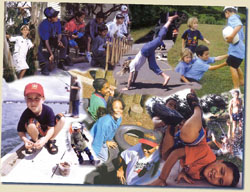|
||||||||||
|
|||||||||||
Questions/instructions:
|
|||||||||||
|
%
responses 2006 ('02) |
||||||||||
| y4 |
y8
|
||||||||||
|
general health benefits (exercise, fitness, energy, concentration) |
112 (78) |
110 (94) |
||||||||
social benefits
(enjoying doing things with others, learning how to relate/work with others, learning how to win/lose, team building) |
18 (24) |
53 (50) |
|||||||||
fun/enjoyment |
71 (69) |
62 (65) |
|||||||||
learning new skills/trying new things |
39 (63) |
42 (57) |
|||||||||
| Strength of reasons: | very strong |
1 (1) |
6 (7) |
||||||||
strong |
16 (18) |
33 (50) |
|||||||||
moderately strong |
52 (51) |
51 (34) |
|||||||||
weak |
31 (30) |
10 (9) |
|||||||||
Total
score: |
3 |
1 (1) |
6 (7) |
||||||||
2 |
16 (18) |
33 (50) |
|||||||||
1 |
52 (51) |
51 (34) |
|||||||||
0 |
31 (30) |
10 (9) |
|||||||||
| Subgroup Analysis: |
Year 4 |
||
Year 8 |
| Commentary: |
| The “Why Play” percentages are accumulations across three student responses. Percentages higher than 100 indicate that the total of the three percentages for that category of response exceeded 100. Year 8 students were much more aware than year 4 students of the social benefits of play. There were only minor differences between Pakeha, Mäori and Pasifika students. There was a small decline in performance for year 8 students between 2002 and 2006. |
